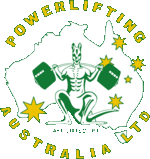Powerlifting Australia
 | |
| Sport | Powerlifting |
|---|---|
| Jurisdiction | Australia |
| Abbreviation | PA |
| Founded | 2007 |
| Affiliation | International Powerlifting Federation |
| Affiliation date | 2007 |
| Headquarters | Melbourne, Victoria |
| Chief Exec | Robert Wilks |
| Other key staff | Chief Financial Officer Malcolm Singer, Chief Information Office Wing Ho, Manager Officiating Pam Cutjar, Manager Memberships Jason Pan, Recordkeeper John Myers, Webmaster Wing Ho |
| Official website | |
|
powerliftingaustralia | |
|
| |
Powerlifting Australia is the governing body for the sport of Powerlifting in Australia. In Australia Powerlifting is governed by Powerlifting Australia Ltd.[1] Powerlifting Australia is recognised by the Australian Sports Commission[2] and the Australian Sports Anti-Doping Agency and is also the affiliate in Australia of the International Powerlifting Federation[3] this includes the IPF’s Oceania[4] and Commonwealth sections.[5] As Powerlifting Australia is affiliated with the IPF, all competitions follow the IPF Technical Rules [6]
Powerlifting Australia provides fair, drug-tested competitions nationwide, from local to National to International events.
History
Powerlifting as we know it today, had its origins in America in the 1960s and also has a connection with the “strength set” consisting of Bench Press, Dead Lift and Curl that was contested in Scotland at about the same time. This had been after a number of years of strong man type competitions that were held in conjunction with bodybuilding and/or Olympic weightlifting competitions.
Within a very short time, the International Powerlifting Federation[3] was created (1971) representing nations from all parts of the world. Today powerlifting competitions are held in more than 71 countries from the tiny Pacific nation of Nauru to USA, South Africa, Asia, Europe and Russia.
The first National championships held in Australia were held in 1971, with 9 men’s divisions being contested. The first women’s National championships were held in 1980 with 9 divisions contested. The most Australian championship wins by Glen Waszkeil from Queensland, who has won 14 national titles between 1975 and 1988 in body weight ranging from 56 kg to 75 kg.
The most distinguished international male competitor for Australia has been Ray Rigby (Victoria) who has won 2 bronze and 2 silver medals at World Championships.
Structure
Membership of Powerlifting Australia comprises individual members, life members and patrons [7]
The Board
The Board comprises up to five Directors with three Directors elected under Rule 33 and 2 Directors appointed by the first 3 Director. The Board appoints a Chairman and deputy-Chairman with each holding a term of one year, but may be appointed. The Chairman and deputy-chairman will each hold office for a term of one year but may be re-appointed. A chairman and deputy-chairman can only serve in those positions for a maximum of 6 years.
Annual General Meeting
An Annual General Meeting shall be held in accordance with the provisions of the Corporations Act 2001 (Cth) and the Constitution and on a date and at a time and venue determined by the Board.
Australia Competition Records
The Powerlifting Australia records[8] represent the best male and female lifts by Powerlifting Australia members in sanctioned IPF competitions which were performed at regional level or higher level or where all 3 referees are of National Level or higher. Records performed in local Powerlifting Australia competitions are recognised based upon certain conditions being fulfilled. Powerlifting Australia must receive positive information suggesting that all three referees at the competition are at least National level referees.
Frozen Records
At the end of 2010, the IPF changed weight class categories and Powerlifting Australia equipped records were frozen as a result. The records below represent what was achieved between 1991-2010:
- Men’s Records (1992-2010)[9]
- Women’s Records (1992-2010)[10]
- School’s Bench Press Records (1992-2010)[11]
See also
References
- ↑ http://www.powerliftingaustralia.com
- ↑ http://www.ausport.gov.au/
- 1 2 http://www.powerlifting-ipf.com
- ↑ "Oceania Powerlifting Federation".
- ↑ "Commonwealth Powerlifting Federation".
- ↑ http://www.powerlifting-ipf.com/rules/technical-rules.html
- ↑ "Powerlifting Australia Constitution 2010". powerliftingaustralia.com.
- ↑ https://powerliftingaustralia.com/australian-records/
- ↑ https://powerliftingaustralia.com/australian-records/frozen-mens-records/
- ↑ https://powerliftingaustralia.com/australian-records/frozen-womens-records/
- ↑ https://powerliftingaustralia.com/australian-records/frozen-schools-bench-press-records/
External links
| Look up website in Wiktionary, the free dictionary. |
| Library resources about Website |